
The Battle of Cape St. Vincent was a naval battle that took place off the southern coast of Portugal on 16 January 1780 during the American Revolutionary War. A British fleet under Admiral Sir George Rodney defeated a Spanish squadron under Don Juan de Lángara. The battle is sometimes referred to as the Moonlight Battle because it was unusual for naval battles in the Age of Sail to take place at night. It was also the first major naval victory for the British over their European enemies in the war and proved the value of copper-sheathing the hulls of warships.

The Battle of Ushant took place on 27 July 1778, and was fought during the American Revolutionary War between French and British fleets 100 miles (160 km) west of Ushant, an island at the mouth of the English Channel off the westernmost point of France. "Ushant" is the anglicised pronunciation of "Ouessant".

Charles-Alexandre Léon Durand, Comte de Linois was a French admiral who served in the French Navy during the reign of Napoleon Bonaparte. He commanded the combined Franco-Spanish fleet during the Algeciras Campaign in 1801, winning the First Battle of Algeciras before losing the Second Battle of Algeciras. He then led an unsuccessful campaign against British trade in the Indian Ocean and South China Sea in 1803, being defeated by a harmless fleet of the East India Company during the Battle of Pulo Aura and ending his cruise and sea-going career being bested in battle by John Warren in the action of 13 March 1806. Following the Bourbon restoration, Linois was appointed Governor of Guadeloupe. He supported Napoleon during the Hundred Days and so, on his return to France, he was forced to resign and was court martialled. Although acquitted, he was placed in retirement and never served again.
Four ships of the French Navy have borne the name Belle Poule.
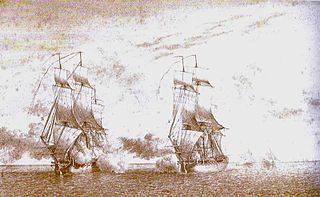
Belle Poule was a French frigate of the Dédaigneuse class, designed by Léon-Michel Guignace. She is most famous for her duel with the British frigate HMS Arethusa on 17 June 1778, which began the French involvement in the American War of Independence.
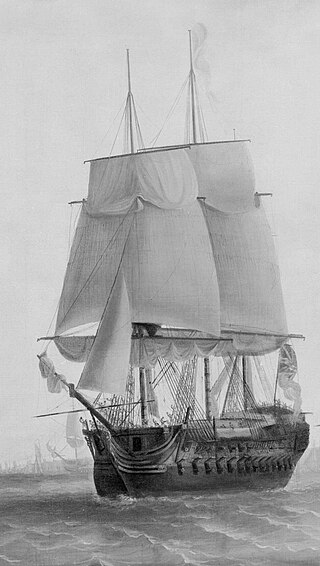
Courageux was a 74-gun ship of the line of the French Navy, launched in 1753. She was captured by the Royal Navy in 1761 and taken into service as HMS Courageux. In 1778 she joined the Channel Fleet, and she was later part of the squadron commanded by Commodore Charles Fielding that controversially captured a Dutch convoy on 31 December 1779, in what became known as the Affair of Fielding and Bylandt. On 4 January 1781, Courageux recaptured Minerva in a close-range action west of Ushant that lasted more than an hour. That April, Courageux joined the convoy under George Darby which successfully relieved the Great Siege of Gibraltar.

HMS Arethusa was a 38-gun Minerva-class fifth-rate frigate of the Royal Navy built at Bristol in 1781. She served in three wars and made a number of notable captures before she was broken up in 1815.
The Saucy Arethusa is a nautical song which, although usually considered "traditional", has been attributed to Prince Hoare, a comic opera librettist, as part of a "musical entertainment" titled The Lock and Key, performed at the Theatre Royal, Covent Garden in 1796.

The Fantasque was a Lion-class 64-gun ship of the line of the French Navy. She is famous for being captained by the French commander Pierre-André de Suffren during the American Revolutionary War.
HMS Bedford was a Royal Navy 74-gun third rate. This ship of the line was launched on 27 October 1775 at Woolwich.
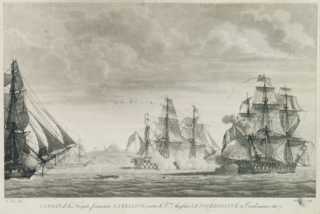
Bellone was an Iphigénie-class 32-gun frigate of the French Navy on plans by Léon-Michel Guignace. She took part in the American Revolutionary War in the Indian Ocean with the squadron under Suffren, and later in the French Revolutionary Wars. She was present at the Glorious First of June.
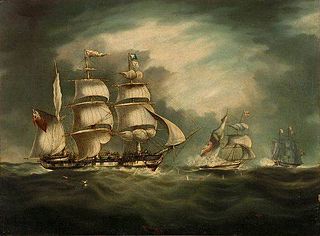
HMS Belle Poule was a Royal Navy fifth-rate frigate, formerly Belle Poule, a Virginie-class frigate of the French Navy that had been built by the Crucy family's shipyard at Basse-Indre to a design by Jacques-Noël Sané. She was launched on 17 April 1802, and saw active service in the East. In 1806 a British squadron under Sir John Borlase Warren captured her off La Palma in the Canary Islands. The Admiralty commissioned her into the Royal Navy as HMS Belle Poule. She was sold in 1816.

Aréthuse was a French frigate, launched in 1757 during the Seven Years' War. She was captured by the Royal Navy in 1759 and became the fifth-rate HMS Arethusa. She remained in Royal Navy service for twenty years until she was wrecked after being badly damaged in battle.

The action of 13 March 1806 was a naval engagement of the Napoleonic Wars, fought when a British and a French squadron met unexpectedly in the mid-Atlantic. Neither force was aware of the presence of the other prior to the encounter and were participating in separate campaigns. The British squadron consisted of seven ships of the line accompanied by associated frigates, led by Rear-Admiral Sir John Borlase Warren, were tasked with hunting down and destroying the French squadron of Contre-Admiral Jean-Baptiste Willaumez, which had departed Brest for raiding operations in the South Atlantic in December 1805, at the start of the Atlantic campaign of 1806. The French force consisted of one ship of the line and one frigate, all that remained of Contre-Admiral Charles-Alexandre Durand Linois' squadron that had sailed for the Indian Ocean in March 1803 during the Peace of Amiens. Linois raided British shipping lanes and harbours across the region, achieving limited success against undefended merchant ships but repeatedly withdrawing in the face of determined opposition, most notably at the Battle of Pulo Aura in February 1804. With his stores almost exhausted and the French ports east of the Cape of Good Hope that could have offered him replenishment eliminated, Linois decided to return to France in January 1806, and by March was inadvertently sailing across the cruising ground of Warren's squadron.

Admiral comte Pierre André de Suffren de Saint Tropez, bailli de Suffren, Château de Saint-Cannat) was a French Navy officer and admiral. Beginning his career during the War of the Austrian Succession, he fought in the Seven Years' War, where he was taken prisoner at the Battle of Lagos. Promoted to captain in 1772, he was one of the aids of Admiral d'Estaing during the Naval battles of the American Revolutionary War, notably taking part in the Siege of Savannah.
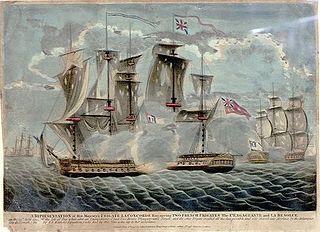
Concorde was a 32-gun frigate of the French Navy, lead ship of her class. Built in Rochefort in 1777, she entered service with the French early in the American War of Independence and was soon in action, capturing HMS Minerva in the West Indies. She survived almost until near the end of the war when HMS Magnificent captured her in 1783. Not immediately brought into service due to the draw-down in the navy after the end of the war, Concorde underwent repairs and returned to active service with the outbreak of war with France in 1793 as the fifth-rate HMS Concorde.
Pierre Servan René Bouvet de Maisonneuve was a French naval officer. He served in several notable battles, notably the action of 17 June 1778, and the battles conducted by Suffren in the Indian Ocean. He was wounded at the Battle of Porto Praya. He was the father of Pierre François Étienne Bouvet de Maisonneuve.
François-Thomas Le Même was a French privateer.
The action of 12 August 1782 was a minor single-ship action that opposed the French 32-gun frigate Bellone to the British 28-gun HMS Coventry in the run-up to the Battle of Trincomalee. Although both ships were frigates, Bellone belonged to the Iphigénie class and was a comparatively large frigate for her time, carrying a battery of 18-pounder long guns, while Coventry was a sixth-rate armed only with 9-pounder long guns. Furthermore, Bellone had the advantage of the wind. The nominal crew of Coventry was about tho thirds of that of Bellone, but in the occasion it was reinforced by the troops she was carrying. In spite of these overwhelming odds, Coventry managed to inflict heavy casualties on Bellone, and most decisively to shoot most of the senior staff. The resulting confusion on Bellone allowed Coventry to escape to Madras.

André-Marie de Gouzillon de Bélizal was a French Navy officer. He served in the War of American Independence.
















